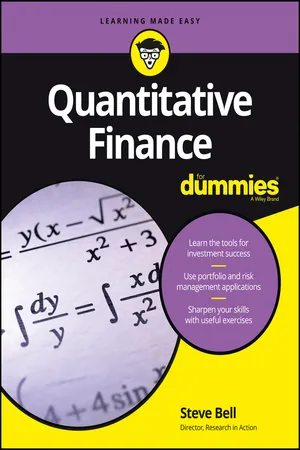
- English
- ePUB (mobile friendly)
- Available on iOS & Android
Quantitative Finance For Dummies
About This Book
An accessible introduction to quantitative finance by the numbers--for students, professionals, and personal investors
The world of quantitative finance is complex, and sometimes even high-level financial experts have difficulty grasping it. Quantitative Finance For Dummies offers plain-English guidance on making sense of applying mathematics to investing decisions. With this complete guide, you'll gain a solid understanding of futures, options and risk, and become familiar with the most popular equations, methods, formulas, and models (such as the Black-Scholes model) that are applied in quantitative finance.
Also known as mathematical finance, quantitative finance is about applying mathematics and probability to financial markets, and involves using mathematical models to help make investing decisions. It's a highly technical discipline--but almost all investment companies and hedge funds use quantitative methods.
The book breaks down the subject of quantitative finance into easily digestible parts, making it approachable for personal investors, finance students, and professionals working in the financial sector--especially in banking or hedge funds who are interested in what their quant (quantitative finance professional) colleagues are up to. This user-friendly guide will help you even if you have no previous experience of quantitative finance or even of the world of finance itself.
With the help of Quantitative Finance For Dummies, you'll learn the mathematical skills necessary for success with quantitative finance and tips for enhancing your career in quantitative finance.
Get your own copy of this handy reference guide and discover:
- An easy-to-follow introduction to the complex world of quantitative finance
- The core models, formulas, and methods used in quantitative finance
- Exercises to help augment your understanding of QF
- How QF methods are used to define the current market value of a derivative security
- Real-world examples that relate quantitative finance to your day-to-day job
- Mathematics necessary for success in investment and quantitative finance
- Portfolio and risk management applications
- Basic derivatives pricing
Whether you're an aspiring quant, a top-tier personal investor, or a student, Quantitative Finance For Dummies is your go-to guide for coming to grips with QF/risk management.
Frequently asked questions
Getting Started with Quantitative Finance
Quantitative Finance Unveiled
Defining Quantitative Finance
Summarising the mathematics
Pricing, mana...
Table of contents
- Cover
- Title Page
- Table of Contents
- Introduction
- Part 1: Getting Started with Quantitative Finance
- Part 2: Tackling Financial Instruments
- Part 3: Investigating and Describing Market Behaviour
- Part 4: Option Pricing
- Part 5: Risk and Portfolio Management
- Part 6: Market Trading and Strategy
- Part 7: The Part of Tens
- Glossary
- About the Author
- Advertisement Page
- Connect with Dummies
- End User License Agreement
